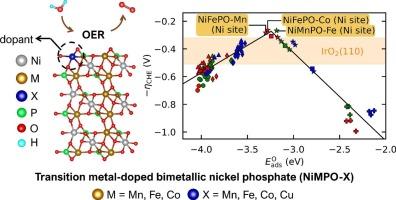通过过渡金属掺杂调整双金属磷酸镍的析氧活性
IF 6.9
2区 材料科学
Q2 CHEMISTRY, PHYSICAL
引用次数: 0
摘要
基于密度泛函理论(DFT)计算,结合计算氢电极(CHE)方法和微动力学模拟,探讨了过渡金属掺杂双金属磷酸镍(NiMPO-X; M = Mn, Fe, Co;掺杂剂 X = Mn, Fe, Co, Cu)的出氧反应(OER)活性。我们的研究结果表明,过渡金属掺杂通过改变局部d带中心和优化表面活性位点的*O结合强度,显著影响了双金属磷酸镍的OER活性。在NiMPO- x体系中,NiFePO-Co的OER性能最好,过电位最小为0.26 V,其次是NiMnPO-Fe(0.27 V)和NiFePO-Mn(0.28 V),优于未掺杂的双金属NiMPO。这些发现突出了掺杂剂选择对于最大化双金属磷酸镍基催化剂OER活性的重要性。本文章由计算机程序翻译,如有差异,请以英文原文为准。


Tuning oxygen evolution activity via transition metal doping in bimetallic nickel phosphates
The oxygen evolution reaction (OER) activity of transition metal-doped bimetallic nickel phosphate (NiMPO-X; M = Mn, Fe, Co; dopant X = Mn, Fe, Co, Cu) has been explored based on density functional theory (DFT) calculations combined with the computational hydrogen electrode (CHE) method and microkinetic simulations. Our findings showed that transition metal doping significantly affects the OER activity of bimetallic nickel phosphates by altering the local d-band center and optimizing the *O binding strength at the surface active site. Among NiMPO-X systems, the best OER performance was achieved by NiFePO-Co with a minimum overpotential of 0.26 V, followed by NiMnPO-Fe (0.27 V) and NiFePO-Mn (0.28 V), outperforming the undoped bimetal NiMPO. These findings highlight the importance of dopant selection to maximize the OER activity of bimetallic nickel phosphate-based catalysts.
求助全文
通过发布文献求助,成功后即可免费获取论文全文。
去求助
来源期刊

Applied Surface Science
工程技术-材料科学:膜
CiteScore
12.50
自引率
7.50%
发文量
3393
审稿时长
67 days
期刊介绍:
Applied Surface Science covers topics contributing to a better understanding of surfaces, interfaces, nanostructures and their applications. The journal is concerned with scientific research on the atomic and molecular level of material properties determined with specific surface analytical techniques and/or computational methods, as well as the processing of such structures.
 求助内容:
求助内容: 应助结果提醒方式:
应助结果提醒方式:


